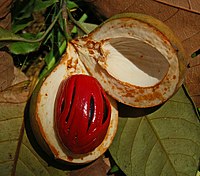
Botanical origin identification of Sicilian honeys based on artificial senses and multi-sensor data fusion
Sign Up to like & getrecommendations! Published in 2017 at "European Food Research and Technology"
DOI: 10.1007/s00217-017-2945-8
Abstract: Quality assessment of honey is often related to its botanical origin, which is traditionally evaluated by a melissopalynology analysis. This technique is quite laborious, time-consuming and requires a high-skilled and trained technician. Another major limitation… read more here.
Keywords: origin identification; origin; artificial senses; identification sicilian ... See more keywords

Saponins - Self-assembly and behavior at aqueous interfaces.
Sign Up to like & getrecommendations! Published in 2017 at "Advances in colloid and interface science"
DOI: 10.1016/j.cis.2017.02.008
Abstract: Saponins are interfacially active ingredients in plants consisting of a hydrophobic aglycone structure with hydrophilic sugar residues. Variations in aglycone structure as well as type and amount of sugar residues occur depending on the botanical… read more here.
Keywords: interfacial properties; saponins self; rheology; structure ... See more keywords

Development of a remote electronic tongue system combined with the VMD-HT feature extraction method for honey botanical origin authentication
Sign Up to like & getrecommendations! Published in 2021 at "Measurement"
DOI: 10.1016/j.measurement.2020.108555
Abstract: Abstract The misrepresentation of honey botanical origin causes serious economic losses for honey producers and consumers. In this work, a novel remote electronic tongue system was developed and utilized to identify honey from different botanical… read more here.
Keywords: system; honey; electronic tongue; method ... See more keywords

Analysis of bacteria associated with honeys of different geographical and botanical origin using two different identification approaches: MALDI-TOF MS and 16S rDNA PCR technique
Sign Up to like & getrecommendations! Published in 2019 at "PLoS ONE"
DOI: 10.1371/journal.pone.0217078
Abstract: In the presented work identification of microorganisms isolated from various types of honeys was performed. Martix-assisted laser desorption/ionization time-of-flight mass spectrometry (MALDI-TOF MS) and 16S rDNA sequencing were applied to study environmental bacteria strains.With both… read more here.
Keywords: 16s rdna; maldi tof; geographical botanical; botanical origin ... See more keywords

Spectroscopic Discrimination of Bee Pollen by Composition, Color, and Botanical Origin
Sign Up to like & getrecommendations! Published in 2021 at "Foods"
DOI: 10.3390/foods10081682
Abstract: Bee pollen samples were discriminated using vibrational spectroscopic methods by connecting with botanical sources, composition, and color. SEM and light microscope images of bee pollen loads were obtained and used to assess the botanical origin.… read more here.
Keywords: color; bee pollen; bee; composition ... See more keywords

Characterization of Botanical Origin of Italian Honey by Carbohydrate Composition and Volatile Organic Compounds (VOCs)
Sign Up to like & getrecommendations! Published in 2022 at "Foods"
DOI: 10.3390/foods11162441
Abstract: Honey is a natural sweetener constituted by numerous macro- and micronutrients. Carbohydrates are the most representative, with glucose and fructose being the most abundant. Minor honey components like volatile organic compounds (VOCs), minerals, vitamins, amino… read more here.
Keywords: botanical origin; honey; organic compounds; composition ... See more keywords

Classification of Prunus Genus by Botanical Origin and Harvest Year Based on Carbohydrates Profile
Sign Up to like & getrecommendations! Published in 2022 at "Foods"
DOI: 10.3390/foods11182838
Abstract: The 1H-NMR carbohydrates profiling was used to discriminate fruits from Rosaceae family in terms of botanical origin and harvest year. The classification was possible by application of multivariate data analysis, such as principal component analysis… read more here.
Keywords: harvest year; botanical origin; classification; origin harvest ... See more keywords

Botanical Origin Influence on Some Honey Physicochemical Characteristics and Antioxidant Properties
Sign Up to like & getrecommendations! Published in 2023 at "Foods"
DOI: 10.3390/foods12112134
Abstract: Five types of honey (multifloral, sunflower, linden, rapeseed, and acacia), from Southern Romania, were classified using chemometrics methods coupled with IR spectroscopy. The botanical origin’s effect on the physicochemical characteristics of honey was studied to… read more here.
Keywords: botanical origin; honey; tested honey; free acidity ... See more keywords

The Use of Fluorescence Spectrometry to Determine the Botanical Origin of Filtered Honeys
Sign Up to like & getrecommendations! Published in 2020 at "Molecules"
DOI: 10.3390/molecules25061350
Abstract: The aim of this study was to determine whether fluorescence spectrometry can be used to identify the botanical origin of filtered honeys. Sixty-two honey samples with different botanical origins, both filtered and unfiltered, were investigated… read more here.
Keywords: fluorescence spectrometry; fluorescence; origin filtered; botanical origin ... See more keywords

Headspace with Gas Chromatography-Mass Spectrometry for the Use of Volatile Organic Compound Profile in Botanical Origin Authentication of Honey
Sign Up to like & getrecommendations! Published in 2023 at "Molecules"
DOI: 10.3390/molecules28114297
Abstract: The botanical origin of honey determines its composition and hence properties and product quality. As a highly valued food product worldwide, assurance of the authenticity of honey is required to prevent potential fraud. In this… read more here.
Keywords: botanical origin; gas chromatography; honey; mass spectrometry ... See more keywords

Cycloartane-Type Triterpenes and Botanical Origin of Propolis of Stingless Indonesian Bee Tetragonula sapiens
Sign Up to like & getrecommendations! Published in 2019 at "Plants"
DOI: 10.3390/plants8030057
Abstract: This study clarifies the chemical constituents and botanical origin of Tetragonula sapiens Cockerell bee propolis collected from Southeast Sulawesi, Indonesia. Propolis samples and resin of Mangifera indica were extracted with 99% ethanol to obtain an… read more here.
Keywords: cycloartane type; tetragonula sapiens; type triterpenes; propolis ... See more keywords